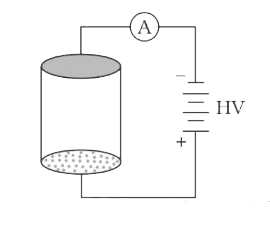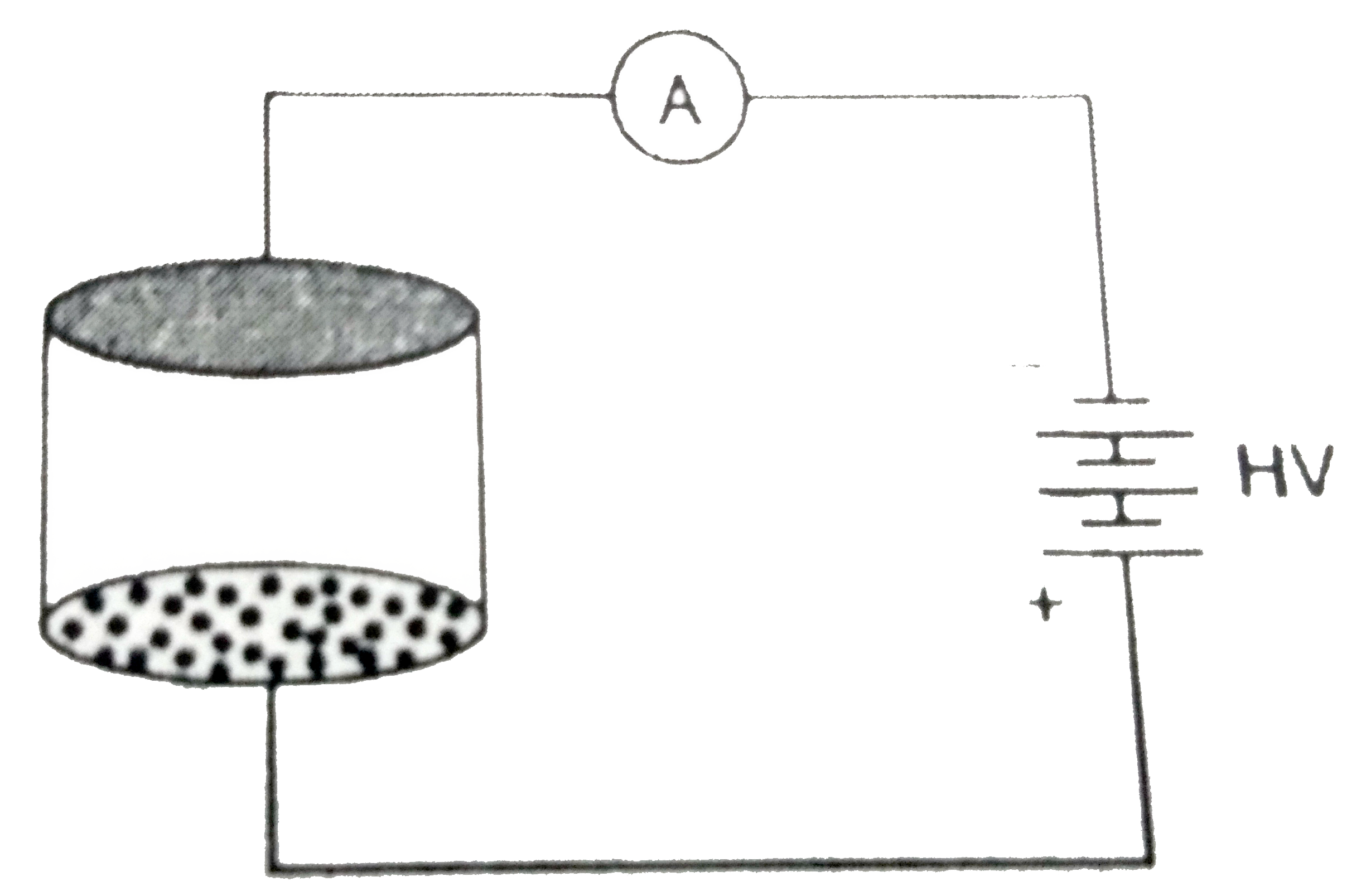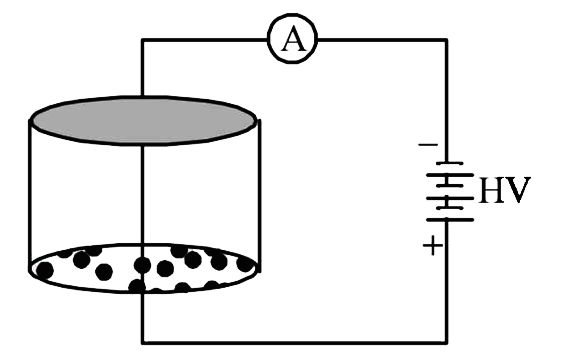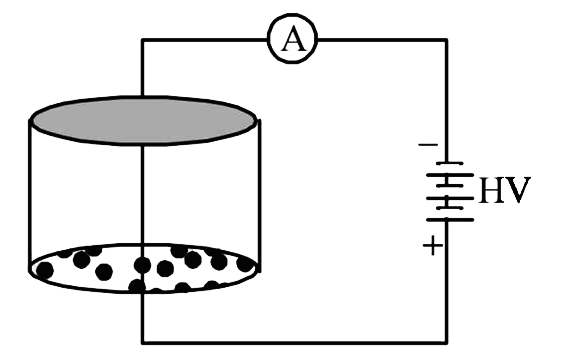Consider an evacuated cylindrical chamber of hight h rigid conducting plates at the ends and an insulating curved surgace as shown in the figure. A number of spherical balls madeof a light weight and soft material and coagted with a conducting material are placed on the bottom plate. The balls have a radius r<<h. Now a high voltage source (HV) is connected across the conducting plates such that th ebottom plate is at+V0and the top plate at−V0. Due to their conducting surface the balls will get charged, will become equipotential with the plate and are repelled by it. The balls will eventually collide with the top plate, where the coefficient of reatitution can be taken to be zero due to the soft nature of the material of the balls. The electric field in the chamber can be considered to be considered to be that of a parallel plate capacitor. Assume tht there are no collisions between the balls and the interaction between them is negligible. (Ignore gravity)

The average current in the steady state registered by the ammeter in the circuit will be
proportional to V20
proportional to V1/20
proportional to the potential V0
zero
The correct Answer is:A
Topper's Solved these Questions
- CURRENT ELECTRICITYBOOK - RESONANCECHAPTER - CURRENT ELECTRICITYEXERCISE - Exrcies-3(PART-2)
23 Videos
- CURRENT ELECTRICITYBOOK - RESONANCECHAPTER - CURRENT ELECTRICITYEXERCISE - High Level Problems (HIP)
21 Videos
- CURRENT ELECTRICITYBOOK - RESONANCECHAPTER - CURRENT ELECTRICITYEXERCISE - Exercise-2 (Part-4)
12 Videos
- COMMUNICATION SYSTEMSBOOK - RESONANCECHAPTER - COMMUNICATION SYSTEMSEXERCISE - Exercise 3
13 Videos
- DAILY PRACTICE PROBLEMBOOK - RESONANCECHAPTER - DAILY PRACTICE PROBLEMEXERCISE - DPP.No.71
1 Videos
Similar Questions
Consider an evacuated cylindrical chamber of height h having rigid conducting plates at the ends and an insulating curved surface as shown in the figure. A number of spherical balls made of a light weight and soft material and coated with a conducting material are placed on the bottom plate. The balls have a radius r<<h . Now, a high voltage source (HV) is connected across the conducting plates such that the bottom plate is at+V0 and the top plate at −V0 .

Due to their conducting surface, the balls will get charged, will become equipotential with the plate and are repelled by it. The balls will eventually collide with the top plate, where the coefficient of restitution can be taken to be zero due to be soft nature of the material of the balls. The electric field in the chamber can be considered to be that of a parallel plate capacitor. Assume that there are no collisions between the balls and the interaction between them is negligible. (Ignore gravity)
Which one of the following statements is correct ?
View SolutionConsider an evacuated cylindrical chamber of height h having rigid conducting plates at the ends and an insulating curved surface as shown in the figure. A number of spherical balls made of a light weight and soft material and coated with a conducting material are placed on the bottom plate. The balls have a radius r<<h . Now, a high voltage source (HV) is connected across the conducting plates such that the bottom plate is at+V0 and the top plate at −V0 .

Due to their conducting surface, the balls will get charged, will become equipotential with the plate and are repelled by it. The balls will eventually collide with the top plate, where the coefficient of restitution can be taken to be zero due to be soft nature of the material of the balls. The electric field in the chamber can be considered to be that of a parallel plate capacitor. Assume that there are no collisions between the balls and the interaction between them is negligible. (Ignore gravity)
Which one of the following statements is correct ?
View Solution
Knowledge Check
Consider an evacuated cylindrical chamber of hight h rigid conducting plates at the ends and an insulating curved surgace as shown in the figure. A number of spherical balls madeof a light weight and soft material and coagted with a conducting material are placed on the bottom plate. The balls have a radius r<<h. Now a high voltage source (HV) is connected across the conducting plates such that th ebottom plate is at+V0and the top plate at−V0. Due to their conducting surface the balls will get charged, will become equipotential with the plate and are repelled by it. The balls will eventually collide with the top plate, where the coefficient of reatitution can be taken to be zero due to the soft nature of the material of the balls. The electric field in the chamber can be considered to be considered to be that of a parallel plate capacitor. Assume tht there are no collisions between the balls and the interaction between them is negligible. (Ignore gravity)

Which one of the following statements is correct ?AThe balls will execute simple harmonic motion between the two platesBThe balls will bounce back to the bottom plate carrying the opposite charge they went up withCThe balls will bounce back to the bottom plate carrying the same charge they went up withDThe balls will stick to the top plate and remain thereConsider an evacuated cylindrical chamber of height h having rigid conducting plates at the ends and an insulating curved surface as shown in the figure. A number of spherical balls made of a light weight and soft material and coated with a conducting material are placed on the bottom plate. The balls have a radius r<<h. Now a high voltage source (HV) is connected across the conducting plates such that the bottom plate is at +V0 and the top plate at −V0. Due to their conducting surface, the balls will get charged, will become equipotential with the plate and are repelled by it. The balls will eventually collide with the top plate, where the coefficient of restitution can be taken to be zero due to the soft nature of the material of the balls. The electric field in the chamber can be considered to be that of a parallel plate capacitor. Assume that there are no collisions between the balls and the interaction between them is negligible. (Ignore gravity)
 A(a) zeroB(b) propotional to the potential V0C(c) proportional to V1/20D(d) proportional to V20
A(a) zeroB(b) propotional to the potential V0C(c) proportional to V1/20D(d) proportional to V20Consider an evacuated cylindrical chamber of height h having rigid conducting plates at the ends and an insulating curved surface as shown in the figure. A number of spherical balls made of a light weight and soft material and coated with a conducting material are placed on the bottom plate. The balls have a radius r<<h. Now a high voltage source (HV) is connected across the conducting plates such that the bottom plate is at +V0 and the top plate at −V0. Due to their conducting surface, the balls will get charged, will become equipotential with the plate and are repelled by it. The balls will eventually collide with the top plate, where the coefficient of restitution can be taken to be zero due to the soft nature of the material of the balls. The electric field in the chamber can be considered to be that of a parallel plate capacitor. Assume that there are no collisions between the balls and the interaction between them is negligible. (Ignore gravity)

Which one of the following statements is correct?A(a) The balls will stick to the top plate and remain thereB(b) The balls will bounce back to the bottom plate carrying the same charge they went up withC(c) The balls will bounce back to the bottom plate carrying the opposite charge they went up withD(d) The balls will execute simple harmonic motion between the two plates
A parallel - plate capacitor is being charged.Show that the displacement current across an area in the region between the plates and parallel to it is equal to the conduction current in the connecting wires.
View SolutionA parallel - plate capacitor is being charged.Show that the displacement current across an area in the region between the plates and parallel to it is equal to the conduction current in the connecting wires.
View SolutionConsider an evacuted cylindrical chamber of height h having rigid conducting plates at the end and an insulting curved surface as shown in the figure. A number of spherical balls made of a light weight and soft material and coated with a conducting material are placed on the bottom plated. The balls have a radius r << h. Now a high voltage source (HV) is connected across the conducting plates such that the bottom plate is at +V0 and the top plate at –V0. Due to their conducting surface, the balls will eventually collide with the top plate, where the plate and are repelled by it. The balls will eventually collide with the top plate, where the coefficient of restitution can be taken to be zero due to the soft nature the material of the balls. The electric field in the chamber can be considered to be that of a parallel plate capacitor. Assume that there are no collisions between the balls and the interaction between them is negligible. (Ignore gravity)
Which one of the following statements is correct?
View SolutionConsider an evacuted cylindrical chamber of height h having rigid conducting plates at the end and an insulting curved surface as shown in the figure. A number of spherical balls made of a light weight and soft material and coated with a conducting material are placed on the bottom plated. The balls have a radius r << h. Now a high voltage source (HV) is connected across the conducting plates such that the bottom plate is at +V0 and the top plate at –V0. Due to their conducting surface, the balls will eventually collide with the top plate, where the plate and are repelled by it. The balls will eventually collide with the top plate, where the coefficient of restitution can be taken to be zero due to the soft nature the material of the balls. The electric field in the chamber can be considered to be that of a parallel plate capacitor. Assume that there are no collisions between the balls and the interaction between them is negligible. (Ignore gravity)
The average current in the steady state registered by the ammeter in the circuit will be
View SolutionThe thermal conductivity of a plate depends on
View Solution
